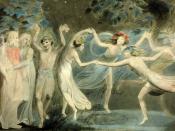The initial setting of the play's scenes is Athens under the reign of Theses and Hippolyta, who are themselves characters from ancient Greek mythology. But it must be understood that the "Athens" of A Midsummer Night's Dream is neither that of ancient Greece nor of its Renaissance counterpart, but an amalgamation of the former with the folk culture of Elizabethan England. After Act I, the play shifts to the "fairyland woods" and remains there through Acts II, III, and IV, returning to "Athens" in Act V for the concluding weddings and the performance of "Pyramus and Thisbe" by the uncouth, unskilled, but irrepressible company of Bottom and his fellow mechanicals.
Act I
Scene i: The play opens in the Athenian court of Theseus as he looks forward to wedding his bride, the former Queen of the Amazons, Hippolyta, some four days hence at the summer Solstice. The "blocking" character of the play arrives in the form of the aged Egeus, the father of Hermia. He wants his daughter Hermia to marry Demetrius and he is vexed by her love for another Athenian youth, Lysander. Hermia refuses her father's demand, while both Lysander and Demetrius press their suits to Theseus. The wise Athenian ruler upholds the law as it stands: he first rules that Hermia must either follow her father's preference for Demetrius or remain unwed forever. But Theseus also gives Hermia and Lysander some time to accommodate themselves to his decision and then calls Egeus into a private, off-stage consultation. All the players leave save Lysander and Hermia, with the former uttering the famous sentiment that, "The course of true love never did run smooth" (I,i., l.134). Another Athenian maid, Helena arrives. She is both a (former) friend of Hermia and a rival for...


